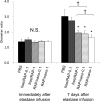Nanoparticles Effectively Target Rapamycin Delivery to Sites of Experimental Aortic Aneurysm in Rats
- PMID: 27336852
- PMCID: PMC4919101
- DOI: 10.1371/journal.pone.0157813
Nanoparticles Effectively Target Rapamycin Delivery to Sites of Experimental Aortic Aneurysm in Rats
Abstract
Several drugs targeting the pathogenesis of aortic aneurysm have shown efficacy in model systems but not in clinical trials, potentially owing to the lack of targeted drug delivery. Here, we designed a novel drug delivery system using nanoparticles to target the disrupted aortic aneurysm micro-structure. We generated poly(ethylene glycol)-shelled nanoparticles incorporating rapamycin that exhibited uniform diameter and long-term stability. When injected intravenously into a rat model in which abdominal aortic aneurysm (AAA) had been induced by infusing elastase, labeled rapamycin nanoparticles specifically accumulated in the AAA. Microscopic analysis revealed that rapamycin nanoparticles were mainly distributed in the media and adventitia where the wall structures were damaged. Co-localization of rapamycin nanoparticles with macrophages was also noted. Rapamycin nanoparticles injected during the process of AAA formation evinced significant suppression of AAA formation and mural inflammation at 7 days after elastase infusion, as compared with rapamycin treatment alone. Correspondingly, the activities of matrix metalloproteinases and the expression of inflammatory cytokines were significantly suppressed by rapamycin nanoparticle treatment. Our findings suggest that the nanoparticle-based delivery system achieves specific delivery of rapamycin to the rat AAA and might contribute to establishing a drug therapy approach targeting aortic aneurysm.
Conflict of interest statement
Figures








Similar articles
-
Rapamycin suppresses experimental aortic aneurysm growth.J Vasc Surg. 2004 Aug;40(2):334-8. doi: 10.1016/j.jvs.2004.05.020. J Vasc Surg. 2004. PMID: 15297830
-
Continuous periaortic infusion improves doxycycline efficacy in experimental aortic aneurysms.J Vasc Surg. 2004 Jun;39(6):1312-21. doi: 10.1016/j.jvs.2004.01.036. J Vasc Surg. 2004. PMID: 15192574
-
A Targeting Nanotherapy for Abdominal Aortic Aneurysms.J Am Coll Cardiol. 2018 Nov 27;72(21):2591-2605. doi: 10.1016/j.jacc.2018.08.2188. J Am Coll Cardiol. 2018. PMID: 30466517
-
B lymphocytes in abdominal aortic aneurysms.Atherosclerosis. 2015 Sep;242(1):311-7. doi: 10.1016/j.atherosclerosis.2015.07.036. Epub 2015 Jul 21. Atherosclerosis. 2015. PMID: 26233918 Review.
-
Clonal expansion of T cells in abdominal aortic aneurysm: a role for doxycycline as drug of choice?Int J Mol Sci. 2015 May 18;16(5):11178-95. doi: 10.3390/ijms160511178. Int J Mol Sci. 2015. PMID: 25993290 Free PMC article. Review.
Cited by
-
Using Molecular Targets to Predict and Treat Aortic Aneurysms.Rev Cardiovasc Med. 2022 Sep 13;23(9):307. doi: 10.31083/j.rcm2309307. eCollection 2022 Sep. Rev Cardiovasc Med. 2022. PMID: 39077712 Free PMC article. Review.
-
Autophagy Modulators: Mechanistic Aspects and Drug Delivery Systems.Biomolecules. 2019 Sep 25;9(10):530. doi: 10.3390/biom9100530. Biomolecules. 2019. PMID: 31557936 Free PMC article. Review.
-
Elastic Fiber Fragmentation Increases Transmural Hydraulic Conductance and Solute Transport in Mouse Arteries.J Biomech Eng. 2019 Feb 1;141(2):021013. doi: 10.1115/1.4042173. J Biomech Eng. 2019. PMID: 30516242 Free PMC article.
-
A Novel Hybrid Drug Delivery System for Treatment of Aortic Aneurysms.Int J Mol Sci. 2020 Aug 2;21(15):5538. doi: 10.3390/ijms21155538. Int J Mol Sci. 2020. PMID: 32748844 Free PMC article.
-
Smad2 inhibition of MET transcription potentiates human vascular smooth muscle cell apoptosis.Atheroscler Plus. 2021 Oct;44:31-42. doi: 10.1016/j.athplu.2021.08.005. Epub 2021 Aug 21. Atheroscler Plus. 2021. PMID: 35445204 Free PMC article.
References
-
- Singh K, Bønaa KH, Jacobsen BK, Bjørk L, Solberg S. Prevalence of and risk factors for abdominal aortic aneurysms in a population-based study: The Tromsø Study. Am J Epidemiol. 2001;154(3):236–244. - PubMed
-
- Brewster DC, Cronenwett JL, Hallett JW Jr, Johnston KW, Krupski WC, Matsumura JS, et al. Guidelines for the treatment of abdominal aortic aneurysms. Report of a subcommittee of the Joint Council of the American Association for Vascular Surgery and Society for Vascular Surgery. J Vasc Surg. 2003;37(5):1106–1117. - PubMed
-
- 2011 Writing Group Members, 2005 Writing Committee Members, ACCF/AHA Task Force Members. 2011 ACCF/AHA Focused Update of the Guideline for the Management of patients with peripheral artery disease (Updating the 2005 Guideline): a report of the American College of Cardiology Foundation/American Heart Association Task Force on practice guidelines. Circulation. 2011;124(18):2020–2045. 10.1161/CIR.0b013e31822e80c3 - DOI - PubMed
-
- Thompson RW, Geraghty PJ, Lee JK. Abdominal aortic aneurysms: basic mechanisms and clinical implications. Curr Probl Surg. 2002;39(2):110–230. - PubMed
MeSH terms
Substances
LinkOut - more resources
Full Text Sources
Other Literature Sources
Medical

